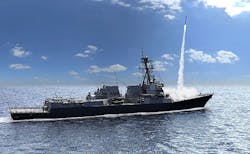Raytheon to begin production of advanced shipboard radar system for guided missile destroyers
Officials of the Naval Sea Systems Command in Washington are asking the Raytheon Integrated Defense Systems segment in Marlborough, Mass., to build the first three AMDR low-rate initial production units under terms of Monday's contract modification. Raytheon prevailed over Northrop Grumman Corp. and Lockheed Martin Corp. to build the AMDR in 2013.
The AMDR will supersede the AN/SPY-1 radar that has been standard equipment on Navy Aegis Burke-class destroyers and Ticonderoga-class cruisers. Monday's order includes non-recurring engineering efforts in support of AMDR production.
The Raytheon AN/SPY-6(V) AMDR will improve the Burke-class destroyer's ability to detect hostile aircraft, surface ships, and ballistic missiles, Raytheon officials say.
The new radar will go aboard Flight III versions of the Burke-class destroyers, which are under construction at Huntington Ingalls Inc. in Pascagoula, Miss., and at the General Dynamics Corp. Bath Iron Works segment in Bath, Me. Flight III is the latest version of the Burke-class guided missile destroyer.
None of these newest ships yet are completed. Navy officials have awarded contracts to build three Flight III Burke destroyers to date -- two at Bath Iron Works and one at Huntington Ingalls. The main goal of the Flight III Burke-class destroyer upgrade is to install the AMDR aboard these new vessels, Navy officials say.
The AN/SPY-6(V) AMDR will provide greater detection ranges, increased discrimination accuracy, higher reliability and sustainability, and lower costs, compared to the AN/SPY-1D(V) radar onboard today’s Burke-class destroyers.
story continues below
The system is built with individual building blocks called radar modular assemblies (RMAs), Raytheon officials say. Each RMA is a self-contained radar in a two-cubic-foot box; RMAs can stack together to form any size array to fit ship mission requirements.
The inherent scalability of the AN/SPY-6(V) AMDR also could enable new instantiations, such as backfits on existing Burke-class destroyers and installation on aircraft carriers, amphibious warfare ships, frigates, the littoral combat ship, and Zumwalt-class land-attack destroyers without significant new radar development costs, Raytheon officials say.
For the Flight III Burke-class destroyer's SPY-6(V) AMDR will feature 37 RMAs. The new radar will be able to see targets half the size at twice the distance of today’s SPY-1 radar. The AMDR will have four array faces to provide full-time, 360-degree situational awareness. Each 14-by-14-foot face is about the same size as today’s SPY-1D(V) radar.
Related: Raytheon to build new Navy EASR shipboard radar for aircraft carriers and other large ships
The AN/SPY-6(V) AMDR will 30 times more sensitive than the AN/SPY-1D(V) in the Flight III configuration, and is being designed to counter large and complex raids, Raytheon officials say. The new radar will have adaptive digital beamforming and radar signal processing for dealing with high-clutter and jamming environments.
The AN/SPY-6(V) radar also is reprogrammable to adapt to new missions or emerging threats. It uses high-powered gallium nitride (GaN) semiconductors, distributed receiver exciters, adaptive digital beamforming, and Intel processors for digital signal processing.
The new radar will feature S-band radar coupled with X-band horizon-search radar, and a radar suite controller (RSC) to manage radar resources and integrate with the ship’s combat management system.
The first of an expected 42 Flight III Burke-class destroyers is expected to join the fleet in 2023. On this order Raytheon will do the work in Marlborough, Mass., and should be finished by October 2020.
For more information contact Raytheon Integrated Defense Systems online at www.raytheon.com, or Naval Sea Systems Command at www.navsea.navy.mil.
Learn more: search the Aerospace & Defense Buyer's Guide for companies, new products, press releases, and videos
